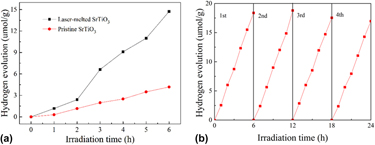Crossref Citations
This article has been cited by the following publications. This list is generated based on data provided by
Crossref.
Yoon, Hee Jung
Kim, Seog K.
Huang, Weixin
and
Sohn, Youngku
2018.
Comparable electrocatalytic performances of carbon- and Rh-loaded SrTiO3 nanoparticles.
Chinese Chemical Letters,
Vol. 29,
Issue. 6,
p.
800.
Zhou, Xuemei
Liu, Ning
Yokosawa, Tadahiro
Osvet, Andres
Miehlich, Matthias E.
Meyer, Karsten
Spiecker, Erdmann
and
Schmuki, Patrik
2018.
Intrinsically Activated SrTiO3: Photocatalytic H2 Evolution from Neutral Aqueous Methanol Solution in the Absence of Any Noble Metal Cocatalyst.
ACS Applied Materials & Interfaces,
Vol. 10,
Issue. 35,
p.
29532.
Nishioka, Shunta
Hyodo, Junji
Vequizo, Junie Jhon M.
Yamashita, Shunsuke
Kumagai, Hiromu
Kimoto, Koji
Yamakata, Akira
Yamazaki, Yoshihiro
and
Maeda, Kazuhiko
2018.
Homogeneous Electron Doping into Nonstoichiometric Strontium Titanate Improves Its Photocatalytic Activity for Hydrogen and Oxygen Evolution.
ACS Catalysis,
Vol. 8,
Issue. 8,
p.
7190.
Dang, N. T.
Long, Phan The
Kozlenko, D. P.
Petrov, Dimitar N.
Ho, T. A.
Tran, N.
and
Yang, D. S.
2018.
Electronic structure and magnetism of SrTi1-xMnxO3 ceramics.
Journal of Applied Physics,
Vol. 124,
Issue. 16,
Kawasaki, Seiji
Takahashi, Ryota
and
Lippmaa, Mikk
2019.
Gradient Carrier Doping as a Method for Maximizing the Photon-to-Current Efficiency of a SrTiO3 Water-Splitting Photoanode.
The Journal of Physical Chemistry C,
Vol. 123,
Issue. 25,
p.
15551.
da Silva, Luís F.
Catto, Ariadne C.
Avansi, Waldir
Mesquita, Alexandre
Maia, Lauro J. Q.
Lopes, Osmando F.
Li, Máximo Siu
Moreira, Mário L.
Longo, Elson
Andrés, Juan
and
Mastelaro, Valmor R.
2019.
Unveiling the efficiency of microwave-assisted hydrothermal treatment for the preparation of SrTiO3 mesocrystals.
Physical Chemistry Chemical Physics,
Vol. 21,
Issue. 39,
p.
22031.
Akbar, W.
Liaqat, T.
Elahi, I.
Zulfiqar, M.
and
Nazir, S.
2020.
Modulated electronic and magnetic properties of 3d TM-doped SrTiO3: DFT + U study.
Journal of Magnetism and Magnetic Materials,
Vol. 500,
Issue. ,
p.
166325.
Baek, Ji-Ye
Duy, Le Thai
Lee, Sang Yeon
and
Seo, Hyungtak
2020.
Aluminum doping for optimization of ultrathin and high-k dielectric layer based on SrTiO3.
Journal of Materials Science & Technology,
Vol. 42,
Issue. ,
p.
28.
Hamalii, V. O.
Peschanskii, A. V.
Popov, A. I.
and
Krainyukova, N. V.
2020.
Intrinsic nanostructures on the (001) surface of strontium titanate at low temperatures.
Low Temperature Physics,
Vol. 46,
Issue. 12,
p.
1170.
Krainyukova, N. V.
Hamalii, V. O.
Peschanskii, A. V.
Popov, A. I.
and
Kotomin, E. A.
2020.
Low temperature structural transformations on the (001) surface of SrTiO3 single crystals.
Low Temperature Physics,
Vol. 46,
Issue. 7,
p.
740.
Jiang, Junzhe
Kato, Kosaku
Fujimori, Hirotaka
Yamakata, Akira
and
Sakata, Yoshihisa
2020.
Investigation on the highly active SrTiO3 photocatalyst toward overall H2O splitting by doping Na ion.
Journal of Catalysis,
Vol. 390,
Issue. ,
p.
81.
Khalid, Muhammad Asad Ullah
Kim, Soo Wan
Lee, Jaewook
Soomro, Afaque Manzoor
Rehman, Muhammad Muqeet
Lee, Byung-Gul
and
Choi, Kyung Hyun
2020.
Resistive switching device based on SrTiO3/PVA hybrid composite thin film as active layer.
Polymer,
Vol. 189,
Issue. ,
p.
122183.
Sudrajat, Hanggara
Fadlallah, Mohamed M.
Tao, Shuxia
Kitta, Mitsunori
Ichikuni, Nobuyuki
and
Onishi, Hiroshi
2020.
Dopant site in indium-doped SrTiO3 photocatalysts.
Physical Chemistry Chemical Physics,
Vol. 22,
Issue. 34,
p.
19178.
Duy, Le Thai
Baek, Ji-Ye
Mun, Ye-Ji
and
Seo, Hyungtak
2021.
Patternable production of SrTiO3 nanoparticles using 1-W laser directly on flexible humidity sensor platform based on ITO/SrTiO3/CNT.
Journal of Materials Science & Technology,
Vol. 71,
Issue. ,
p.
186.
Kumar, Ashish
and
Krishnan, Venkata
2021.
Vacancy Engineering in Semiconductor Photocatalysts: Implications in Hydrogen Evolution and Nitrogen Fixation Applications.
Advanced Functional Materials,
Vol. 31,
Issue. 28,
Liu, Junying
Wei, Zhidong
and
Shangguan, Wenfeng
2021.
Enhanced photocatalytic water splitting with surface defective SrTiO3 nanocrystals.
Frontiers in Energy,
Vol. 15,
Issue. 3,
p.
700.
Manchala, Saikumar
Gandamalla, Ambedkar
Rao, Vempuluru Navakoteswara
Venkatakrishnan, Shankar Muthukonda
and
Shanker, Vishnu
2022.
Solar-light responsive efficient H2 evolution using a novel ternary hierarchical SrTiO3/CdS/carbon nanospheres photocatalytic system.
Journal of Nanostructure in Chemistry,
Vol. 12,
Issue. 2,
p.
179.
Welter, Eike S.
and
Gläser, Roger
2022.
Green Photocatalytic Semiconductors.
p.
723.
Yao, Yisen
Li, Qiaoqiao
Chu, Weibin
Ding, Yi-min
Yan, Luo
Gao, Yang
Neogi, Arup
Govorov, Alexander
Zhou, Liujiang
and
Wang, Zhiming
2023.
Exploration of the origin of the excellent charge-carrier dynamics in Ruddlesden–Popper oxysulfide perovskite Y2Ti2O5S2.
Physical Chemistry Chemical Physics,
Vol. 25,
Issue. 48,
p.
32875.
Abd Elkodous, M.
Kawamura, Go
and
Matsuda, Atsunori
2023.
Al–SrTiO3/Au/CdS Z-schemes for the efficient photocatalytic H2 production under visible light.
International Journal of Hydrogen Energy,
Vol. 48,
Issue. 86,
p.
33456.






